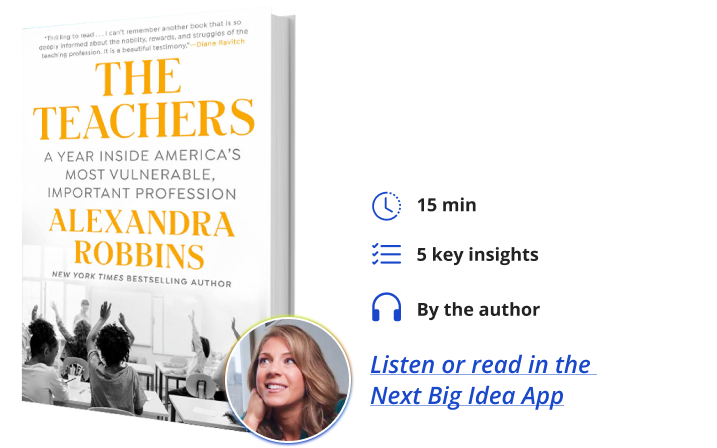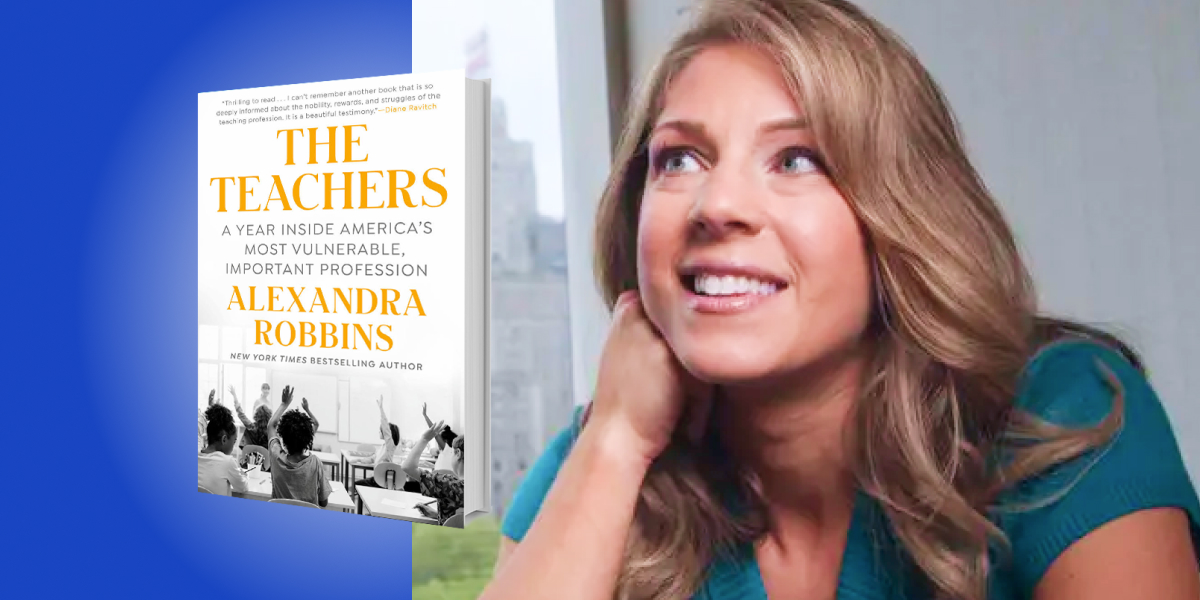Alexandra Robbins is an award-winning investigative reporter who has been honored for “Distinguished Service to Public Education.” The author of five New York Times bestselling books and a Goodreads Best Nonfiction Book of the Year, she has written for several publications, including The New York Times, The New Yorker, The Wall Street Journal, The Washington Post, and The Atlantic, and has appeared on hundreds of television shows, including 60 Minutes, Today, CBS Mornings, The Oprah Winfrey Show, The View, and The Colbert Report.
Below, Alexandra shares 5 key insights from her new book, The Teachers: A Year Inside America’s Most Vulnerable, Important Profession. Listen to the audio version—read by Alexandra herself—in the Next Big Idea App.

1. Teacher burnout is a myth.
Teacher burnout is such a popular phrase that Merriam Webster’s two featured contextual examples of burnout are about teachers, 1. “Teaching can be very stressful, and many teachers eventually suffer burnout” and 2. “The burnout rate among teachers.” The International Journal of Occupational Medicine and Environmental Health reports that, “It is confirmed that teachers have the highest burnout levels as compared to other professionals in social services.”
Let’s take a closer look at what burnout actually means. It’s defined as workplace-induced stress and exhaustion, and negative feelings about one’s job. Experts have identified several causes of teacher burnout, including inadequate workplace support and resources, unmanageable workload, high-stakes testing, unsupported disruptive students, and a wide variety of student needs without resources and personnel to meet those needs.
One example that causes burnout might be if a district adds a new student to a school who bumps the class size over the cap, but then doesn’t allot a new class to the grade. The class is then overfull and the teacher is expected to manage a big class with no extra help, hours, or pay. Another example is if a student has complicated special needs, but the county plunks the kid into a school without allowing the school to hire a paraprofessional to help meet those needs. This is what happened to Miguel, one of the teachers featured in the book, who was expected to manage with no extra help, hours, or pay. A third example would be if the district institutes new curriculum standards but doesn’t provide textbooks or guides to teach those standards, this is what happened to Penny and Rebecca.
None of these issues are within a teacher’s control, but rather than fixing them, school systems often say that teachers struggling with these obstacles are burned out and therefore should just learn to relax and do a better job of self-care. This suggests that the burden is on the teachers to pay for a massage or somehow find the time and headspace to meditate to alleviate the stress caused by a job that’s impossible to do during paid contractual hours.
“The teacher-blaming mentality has escalated in recent years”
Therefore, the premise of teacher burnout is a myth, a convenient fiction that blames teachers for not being able to cope rather than faulting school systems that set up teachers to fail. The teacher-blaming mentality has escalated in recent years and the phrase “teacher burnout” is a prime example. Instead of presenting the problem as “Teachers have the highest burnout levels,” we should reframe the issue as “School systems are the worst employers at providing employees with necessary support and resources.”
2. There is no teacher shortage.
Teacher shortage may be the popular term for the unprecedented number of classroom vacancies, but it’s inaccurate. There is not a shortage of potential, qualified, and aspiring educators, there is a shortage of teaching jobs that adequately treat and compensate Bachelors- to Masters-level professionals who would want to be teachers. Miguel, for example, a highly trained educator and mentor, loved his students and thoroughly enjoyed teaching them. But he still expected he would leave teaching in June because his district created so many unnecessarily difficult roadblocks that the stress of the role outweighed his passion for the work.
Presently, teachers are under siege from all sides. Students are more disruptive than before the pandemic, and just one disruptive student can affect an entire class. District officials, and sometimes principals, overload teachers with time-consuming obligations, without giving them the resources, tools, hours, or structural support necessary to execute them. On top of this, the teacher pay gap has hit a record high; U.S. teachers are paid about 24% less than professionals with similar education and experience. Furthermore, certain sectors of politicians and parents are loudly vocalizing disrespect for the profession like never before, censoring classroom discussions and materials, and stripping teachers of the autonomy they should have in a job that only they are trained and certified to do. As a result, unprecedented numbers of teachers are fleeing the profession. There’s not a shortage of people, there’s a shortage of support.
3. Teaching has become a catch-all profession.
Being a teacher doesn’t involve only academic teaching anymore, the job has become a catch-all, as districts and administrators pile on extra, non-teaching responsibilities. For example, many administrators now place the burden of reporting and managing disciplinary infractions on teachers, expecting them to contact parents and fill out paperwork. Middle and high school teachers can have on average 180 students; a Utah high school English teacher recently had 263. Tracking down parents and completing documentation for even a small fraction of those numbers adds up to hours that teachers don’t have. A Missouri teacher is given planning time from 7:40 to 8:30 a.m., plus a 20-minute lunch at 10:30 in the morning, that’s the extent of her paid non-class time. It’s hard enough to correct and edit writing for that many students in 50 minutes, let alone handle disciplinary calls and documentation that should be managed by school administrators.
“Society isn’t properly taking care of children from underserved communities, so it has become the responsibility of public schools to feed them.”
Other non-teaching responsibilities include a rise in mandated compliance training, bus, recess, hallway, and carpool duties that admins and non-instructional staff could be supervising. That also includes mandatory chaperoning of after-hour events. Additionally, teachers have to teach social-emotional learning and provide informal counseling to students because districts aren’t hiring enough counselors.
On top of the additional time, at least 94 percent of public school teachers pay out of pocket for classroom supplies. Teachers personally spend an average of about $500 annually on books, learning tools, classroom decor, educational software, math manipulatives, school supplies, and snacks for students. Many teachers buy extra food to slip into the backpacks of food-insecure students during recess to make sure they have something to eat at home. Society isn’t properly taking care of children from underserved communities, so it has become the responsibility of public schools to feed them. As a West Virginia middle school teacher said, “We cannot be everything to everyone, society wants us to cure their ills but treats us like crap.”
The 2010s’ surge of school shootings led some districts to insist on arming their teachers, adding security enforcement to their list of duties. School systems expected teachers to put their bodies between a shooter and their students, to take a bullet as part of the job. Why? Because society’s only nationwide substantive change to address school gun violence between the 2012 Sandy Hook Elementary School massacre and the 2022 Robb Elementary School massacre was to train teachers to hide their students and barricade the door. Once again, the burden falls on underfunded, under-resourced educators to bear responsibility for larger societal failures.
4. Education has an easier fix than you’d think.
Our education system is easier to fix than politicians make the problems out to be. Districts are wasting money on programs and curriculum initiatives that add to teachers’ workloads without helping students. They’re wasting money and instructional time on standardized tests and they’re wasting money on central office bloat: district administrative positions that receive six-figure salaries but don’t do anything tangible to help directly in schools.
Students aren’t inspired to learn or succeed by district administrators, tests, or yet another newfangled curriculum initiative. They’re inspired by people, whether it’s the school librarian who connects them with a book that validates their sense of self, or a teacher who creates an “a-ha” moment that sparks children’s confidence in the classroom. A Johns Hopkins study found that Black students who have one Black teacher by 3rd grade are 13 percent more likely to enroll in college; the likelihood jumps to 32 percent for students who have two Black teachers. According to the Center for Black Education, Black students who have one Black teacher in their early education are up to 39 percent less likely to drop out of school.
“Students aren’t inspired to learn or succeed by district administrators, tests, or yet another newfangled curriculum initiative.”
The game-changer for students is having a great teacher. So that’s where funding and resources should go: to the teachers, higher pay, smaller classes, more support staff, fewer non-teaching duties, and enough protected school-day planning time to fulfill their job within their paid contractual hours. If teachers are supported, well-treated, and properly compensated, schools will improve. Studies show students’ math and English scores are significantly higher in districts that pay teachers higher base salaries. As an Oregon high school teacher said, “I see the difference I make in just one year for my students. Imagine classrooms around the country filled with teachers who have support. With the right support, I could help every student I see, and I know most teachers feel the same. We could fundamentally change the lives of millions of children, but we’re simply too overwhelmed to meet their needs in the way we know we should.”
5. Teachers can dislike the job but still love to teach.
For all of the aforementioned reasons, the job of being a teacher has become unnecessarily grueling, but it’s still possible for educators to love teaching, even if they dislike the job. LeVar, a Texas middle school PE and health teacher is one of the 70 percent of teachers who have had to work a second job to make ends meet. On days when LeVar isn’t coaching the school football, soccer, or basketball teams, he drives straight from school to his next job as a carpet cleaner from 4 to 7 p.m., a job he also works all day Saturdays. For a long time, every weekday he came home to grade papers, prepare lessons, and sleep for a couple of hours before working the 10:45 p.m. to 6:45 a.m. shift as a hospital tech. He was back at school at 7:15 am. He barely saw his wife and two young daughters.
Eventually, LeVar’s high blood pressure led his doctor to tell him to quit the night shift. But his physical and emotional strains continued as he struggled to figure out how else to supplement his teacher salary of about $30,000 after taxes and insurance payments. At various times, both his water and cell phone were cut off. He thought he tore knee ligaments, but he couldn’t get them looked at because there was no one to work if he couldn’t. He had to pretend he’d already eaten elsewhere just so his girls could eat more, always thinking about how he was going to feed his family.
LeVar could make more money in another job, but he never once considered leaving the teaching field. When asked why he stays despite the struggles, his answer echoed the feelings of hundreds of teachers interviewed across the country. He said, “I love being a teacher because I get the chance to make a difference in someone’s life. Teaching can be hard, but it makes my soul happy.”
When you strip away the bureaucratic baloney, teaching is a beautiful job. Teachers talk about the joy they experience when a student grasps a concept or makes a text connection, when a class is so engaged by a great lesson that they’re surprised and disappointed by the bell, and when former students reach out to say hello. Teachers delight in classes that are like families, with their own unique dynamics and inside jokes. Teachers treasure their friendships with colleagues. A Washington, DC teacher said, “The friendships you make with teaching colleagues are deep because … this field draws people who value relationships and know how to show up.”
Teaching can make your soul happy. But with that said, if districts don’t respect, support, and pay teachers, like the skilled professionals they are, the meaningfulness of the profession will no longer be enough to prevent teachers from leaving it. That’s why we must stand up for teachers now.
To listen to the audio version read by author Alexandra Robbins, download the Next Big Idea App today:































